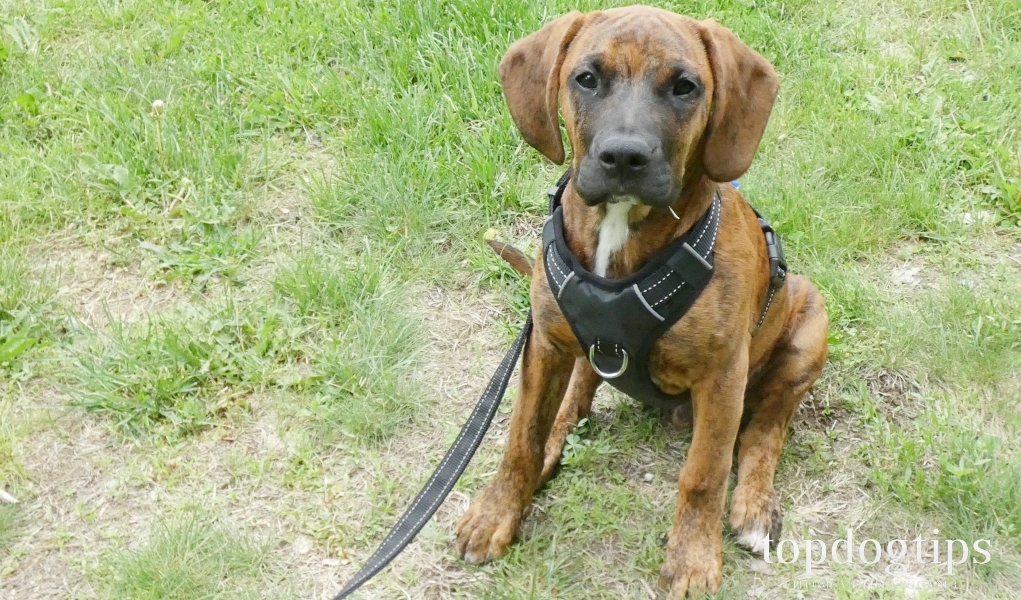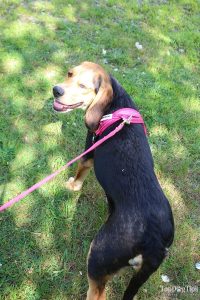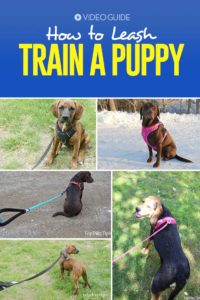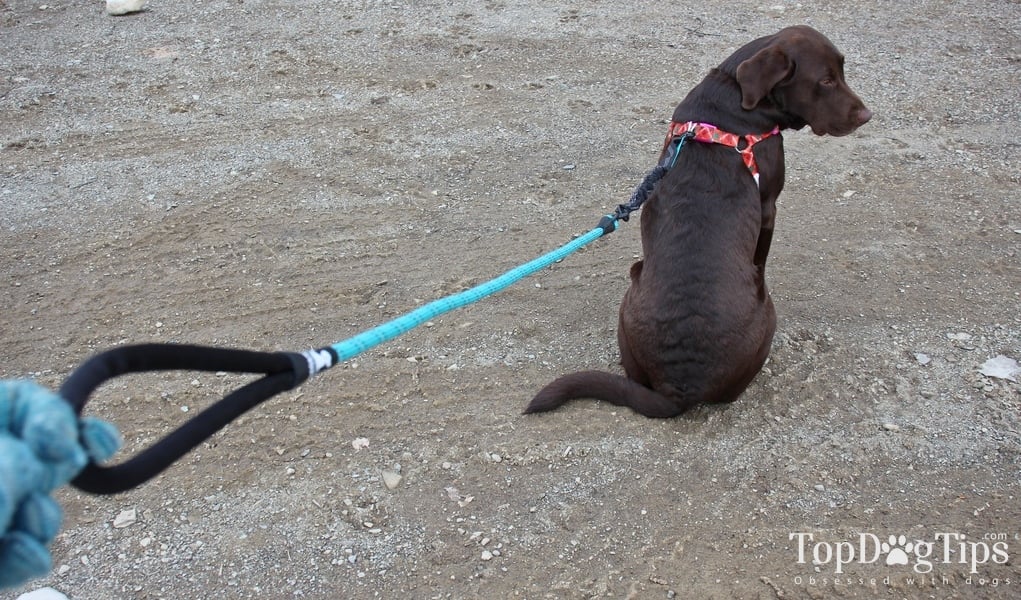Every puppy needs regular exercise to stay healthy and fit. Some pet owners have a large piece of property for their new pet to run around on.If you don't, you'll need to take your new companion for walks every day. Learning how to leash train a puppy is an imperative part of your puppy training regiment.
Puppies are known for having an abundance of energy. If you don't allow them to burn excessive energy, you are sure to see behavior problems and stress issues pop up. Puppies with extra energy will find something to entertain themselves, and it may very well be chewing up your belongings or ripping your furniture apart.
As with any type of training, leash training will take a lot of patience and time. In my step-by-step video guide above, you'll see how difficult it can be to work with a silly puppy that just wants to roll in the grass and chase butterflies.
Every puppy is different. While some may pick up on leash training after just a couple of weeks, it may take others months to become 100% well behaved while walking on a lead. Either way, your dog definitely won't be leash trained in one afternoon.
Learning how to leash train a puppy is the easy part. It's putting these skills to use that will be tricky. Stay calm and be patient, and you'll be walking with your furry friend in no time.
How to Leash Train a Puppy
 1. Get him used to the gear
1. Get him used to the gear
Hopefully your puppy isn't quite as goofy as ours! Our puppy, Thor, is about 6 months old. We've been working with him on leash training since we adopted him at 8 weeks old. He's making a lot of progress, but we're still consistently working on leash training him almost every day.
As I explain in my video guide above, I prefer to use a harness instead of a collar when learning how to train a puppy (or any dog for that matter). You'll need to find the right collar or harness for your puppy, but I would definitely recommend a harness for any dog that is new to leash walking.
Your puppy isn't going to understand what is going on at first, meaning he may pull on the leash or try to back out of a collar. Of course, if a collar is properly fit this shouldn't be an issue. But, think of the pressure and strain that this is going to put on your pet's neck and throat.
 A harness spreads the pressure out evenly through your pup's chest causing him no harm and eliminating the risk of injury to his throat. Whichever you choose, you need to be sure that the device is properly fit on your puppy. Collars should fit tightly around his neck, but not too tightly. You should be able to comfortably slip two fingers between the collar and your puppy's neck.
A harness spreads the pressure out evenly through your pup's chest causing him no harm and eliminating the risk of injury to his throat. Whichever you choose, you need to be sure that the device is properly fit on your puppy. Collars should fit tightly around his neck, but not too tightly. You should be able to comfortably slip two fingers between the collar and your puppy's neck.
RELATED GUIDE: How To Put On A Dog Harness – Step-by-Step Guide
As in my video above, I'm going to say harness, but if you use a collar that's fine too. Once the harness is properly fit, allow your puppy to have plenty of time to walk around with it on. He needs to get used to the feel of the harness, and he will quickly realize that it is comfortable to wear and doesn't restrict his range of motion.
When he's used to the harness, you'll need to give him some time to get used to the leash. Place it on the floor where he can sniff it, but be sure to keep an eye out to make sure he doesn't chew it.
Eventually, he'll realize that the leash isn't a toy or a threat. He'll ignore the leash at this point. Now, attach the leash to the harness and let your puppy drag it around. Again, you'll need to monitor him closely to ensure he doesn't chew the leash. Once he's comfortable having the leash attached to the harness you can move on to learn how to leash train a puppy.
2. Use treats and praise as rewards for good behavior
This is an easy one! Most puppies will be motivated by small training treats. If you have a picky pup, try using bits of cheese or meat to entice him. In the beginning, reward Fido with a treat and verbal/physical praise. As the training process moves forward, you can stop using training treats and just reward with verbal and physical raise.
MORE INFO: Top 5 Best Dog Training Treats
3. Be patient
I briefly mentioned that all types of training takes patience. If you get frustrated your puppy is going to pick up on it, and he'll become upset too. If you feel yourself getting angry or frustrated, take a break and come back to your training later.
 Learning how to leash train a puppy isn't something that will happen in one session. It won't even happen in a few sessions. Training your new canine companion to do anything will take many sessions over the course of weeks or even months.
Learning how to leash train a puppy isn't something that will happen in one session. It won't even happen in a few sessions. Training your new canine companion to do anything will take many sessions over the course of weeks or even months.
Puppies can be especially frustrating to train, because they have a lot of excess energy. Be sure to have a play session before beginning your training. If you notice your puppy getting overly excited, give up on the training and let him play. Your dog won't be able to focus if he's in a hyper mood, so it's best to take a break and come back to your training session when he's a little more calm.
Similarly, when training a puppy you need to keep your dog's happiness in mind. Work at your pet's pace. If he is having fun and enjoying the training, continue; if he's starting to get discouraged, take a break.
4. Do NOT allow pulling!
Most dog owners think that if they just coax their pup along and pull on the leash a little bit he will naturally follow and begin to walk along. While this may work with some puppies, it could result in your pooch getting injured.
Pulling on the leash may cause your pup to become nervous and view the leash as a threat. It may also backfire and cause him to become scared of the leash, which will lead to him trying to back out of his harness and escape.
5. Begin with short walks and increase distance gradually
When your puppy is completely comfortable walking around with his leash and harness on, you can begin moving around your yard. You'll need to build your puppy's stamina gradually.
 Start with short walks around the yard or down your street. 5 minutes walks are a great starting point, and you can increase in 5-minute intervals once your pup gets a little older and has built up his endurance.
Start with short walks around the yard or down your street. 5 minutes walks are a great starting point, and you can increase in 5-minute intervals once your pup gets a little older and has built up his endurance.
Be sure to walk with your dog EVERY day – multiple times per day if possible. While patience and consistency are key, you also don't want your puppy to go too long between training sessions. Multiple daily walks will keep the training fresh and help your dog get the hang of things faster.
READ NEXT: The 7 Best Training Leashes for Puppies and Adult Dogs













